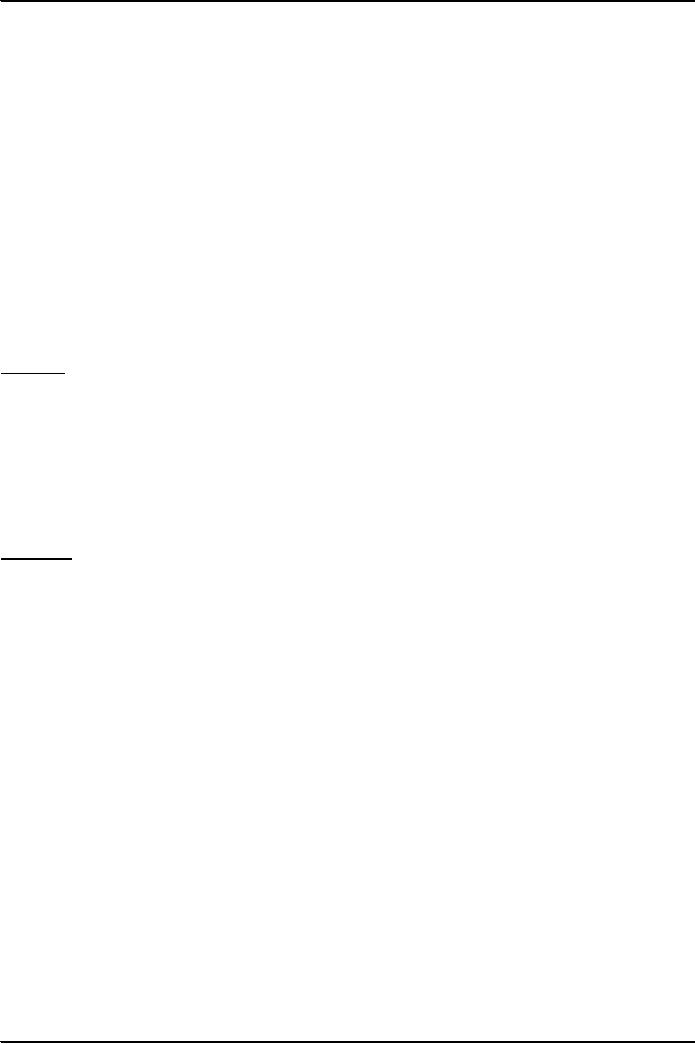 |
CULTURE:Universality, Components of Culture, Symbols, Language |
| << ORGANIZATIONS:Utilitarian Organizations, Coercive Organizations |
| CULTURE (continued):Beliefs, Norms, Cultural Diversity >> |

Introduction
to Sociology SOC101
VU
Lesson
9
CULTURE
Culture is
people's way of life. It is
their pattern of behavior, which
has been created by human
beings.
Culture
includes: Intangible
(non-material)
items like values, beliefs,
norms, language, and ideas
(ideologies:
perception
of reality) that govern the way of life.
The way we play our
roles.
+
Tangible things material objects.
Human beings have created
this way of life, which
includes both
material
and non-material objects. Hence
some Anthropologists call it as
man- made part of
the
environment.
Culture is the patterns of behavior and
the products of the patterns of
behavior
Do
non-humans have a
culture?
Non-humans
guided by instincts. They have a
biological programming. Humans guided by culture,
which
may
be called as social programming. Culture is
learned, shared, transmitted, and it is
changing.
Some
specific features of
culture:
·
Universality:
Culture is
universal. There is no society without
culture. As part of the cultures
there
are many aspects that
are found in almost all the
societies. For example the
institutions like
marriage
and family, religion,
education, polity, economy,
and sports are found
all over the world.
Societies
have developed values, norms,
beliefs, and other patterns
of behavior that govern the
system
of marriage and family. One could
find such a pattern all over
the world, and the same
is
applicable
to religion, education, political
behavior, economic behavior,
and so on.
·
Variability:
There is
variability in the universals of culture. By
looking at the institution of
marriage
and family one could
see so much of variation in it
within Pakistan, notwithstanding
the
differences
in other societies. The
arranged marriages, love
marriages, exchange
marriages,
marriages
by purchase, marriages within as
well as outside the kin
network, are all variations
that are
found
in Pakistan. Then one could
see the differences in wedding ceremonies
all over the country.
Joint
families and nuclear
families, single earner
families and dual earner
families, patriarchal
families
and egalitarian families, patrilocal
families and matrilocal families
are some other
aspects
reflecting
the variability of family in Pakistani
society. Similarly one comes
across variations in
religion
all over the world.
Kingship, dictatorship, democracy,
parliamentary form of democracy
or
presidential
form, adult franchise or
selective voting rights,
voter age are all variations
in the
political
systems followed by different
nations. Economic systems also vary
from the extremes of
socialism
and capitalism to any
variation on the scale.
·
Learned:
Culture
is learned through the process of
interaction with others. It is
not inherited
through
the biological process. We learn to
talk, to walk, and to act as
our elders train us.
Nature
has
given us the potential to talk but we
speak variety of languages, which
are all created by
human
beings
and there is so much of
variation within as well as
outside Pakistan. Also human
being have
the
capacity to learn a variety of languages.
Similarly other ways of life,
which is culture, are
learned.
·
Shared:
Culture is
not the property of one
individual or of a group. It is shared
with other
members
of society. You are sharing
T V transmission with others,
sharing a classroom
with
others,
sharing the road with others,
and sharing the knowledge with
others. You are
sharing
culture
with others because you
are a social being.
·
Transmitted:
Culture
does not end with the
death of a person or a group. During
its lifetime that
individual
or group tries to pass on
its culture to the future generation.
This is how every new
crop
of
babies does not start
from a scratch rather they build on what
they have already received.
That
is
how culture grows and that
is how our culture becomes richer ad
richer.
23

Introduction
to Sociology SOC101
VU
·
Changing:
Culture is
continuously changing. The patterns of
behavior transmitted by one
generation
to another are continuously in the process of
modification for catering to the
changing
needs
of time and demands of people. New
technologies are developed and
are borrowed from
other
groups and societies. With
the increase in the contact between
different societies the
cultures
are
changing very fast and may
be moving toward some kind
of global culture.
Three
similar terms: Culture, Nation, and
Society
Culture:
Shared way of life.
Nation: A
political entity within
designated borders.
Society: The
organized interaction of people in a
nation or within some other
boundary.
Pakistan:
nation and society, but
may have many
cultures.
Multicultural:
Includes various ways of life
that blend together.
Components
of Culture
Symbols:
Anything
that carries a particular meaning
recognized by people who share culture.
Whistle,
flashing
light, thumbs up are all
symbols.
Human
beings have the capacity to
create symbols with
different meanings associated
with each. These
symbols
are used as means of communication
and thereby become part of
our language.
Even
the buildings, dress, the flag, and a type of
color may be taken as
symbols indicating some
aspect of
human
behavior as well as society's
outlook. Red, green, white,
blue, pink, each of the colors
stands for
something
in the society. Blue jeans are
quite commonly used in Pakistan.
Can you find out
that these are
symbol
of what?
Language:
System
of symbols that allows
members of a society to communicate
with one another.
Symbols
may be oral and these could
be written words. We have
oral cultural traditions. Human
beings
have
developed different alphabet as part of
written language. Language
is the major means of
cultural
transmission.
Is
language uniquely
human?
24
Table of Contents:
- THE ORIGINS OF SOCIOLOGY:Auguste Comte, The Fields of Sociology
- THE SOCIOLOGICAL PERSPECTIVE:Society affects what we do
- THEORETICAL PARADIGMS:Salient Paradigms, Critical Evaluation
- SOCIOLOGY AS SCIENCE:Empirical, Verifiable, Cumulative, Self-Correcting
- STEPS IN SOCIOLOGICAL INVESTIGATION:Exploration/Consultation
- SOCIAL INTERACTION:Social Status, ROLE, The Social Construction of Reality
- SOCIAL GROUPS:Primary and Secondary Groups, Reference Group, Networks
- ORGANIZATIONS:Utilitarian Organizations, Coercive Organizations
- CULTURE:Universality, Components of Culture, Symbols, Language
- CULTURE (continued):Beliefs, Norms, Cultural Diversity
- CULTURE (continued):Culture by social class, Multiculturalism, Cultural Lag
- SOCIALIZATION: HUMAN DEVELOPMENT, NATURE, Social Isolation
- UNDERSTANDING THE SOCIALIZATION PROCESS
- AGENTS OF SOCIALIZATION:The Family, The School, Peer Groups, The Mass Media
- SOCIALIZATION AND THE LIFE COURSE:CHILDHOOD, ADOLESCENCE
- SOCIAL CONTROL AND DEVIANCE:Crime, Deviants, Stigma, Labeling
- THE SOCIAL FOUNDATIONS OF DEVIANCE:Cultural relativity of deviance
- EXPLANATIONS OF CRIME:Sociological explanations
- EXPLANATIONS OF CRIME -- CONTINUED:White-Collar Crime, Conflict Theory
- SOCIAL DISTRIBUTION OF CRIME: EXPLANATIONS, Gender and Crime
- SOCIAL STRATIFICATION: INTRODUCTION AND SIGNIFICANCE
- THEORIES OF CLASS AND STRATIFICATION – I:Critical evaluation
- THEORIES OF SOCIAL CLASS AND STRATIFICATION – II
- THEORIES OF CLASS AND SOCIAL STRATIFICATION – III
- SOCIAL CLASS AS SUBCULTURE
- SOCIAL MOBILITY:Structural factors, Individual factors, Costs
- THE FAMILY: GLOBAL VARIETY, Marriage Patterns, Patterns of Descent
- FUNCTIONS OF FAMILY:Reproduction, Social placement
- FAMILY AND MARRIAGE IN TRANSITION:Family is losing functions
- GENDER: A SOCIAL CONSTRUCTION, Gender socialization
- GENDER SOCIALIZATION:Role of family, Gender Stratification
- EXPLANATIONS OF GENDER INEQUALITY:Conflict Explanations, Feminism
- FUNCTIONS OF SCHOOLING:Cultural Innovation, School Tracking
- ISSUES IN EDUCATION:Low Enrollment, High Dropout, Gender Disparity
- POPULATION STUDY AND ITS SIGNIFICANCE:Crude Birth Rate
- THEORY OF POPULATION GROWTH:Theory of Demographic Transition
- POPULATION PROFILE OF PAKISTAN:World Population Growth
- POPULATION PROFILE OF PAKISTAN (Continued):Age Distribution, Sex Composition
- IMPLICAIONS OF POPULATION GOWTH:Additional GDP needed per year
- POPULATION POLICY:Goals of Population Policy, Objectives, Strategies
- ENVIRONMENT AND SOCIETY:Global Dimension, Historical Dimension
- ENVIRONMENTAL ISSUES:Preserving Clean Water, Clearing the Air
- SOCIAL CHANGE:Social change is controversial.
- CAUSES OF SOCIAL CHANGE:Culture and Change, Conflict and Change, Modernization
- MODERNITY AND POST MODERNITY:Cultural Patterns, Post-modernity